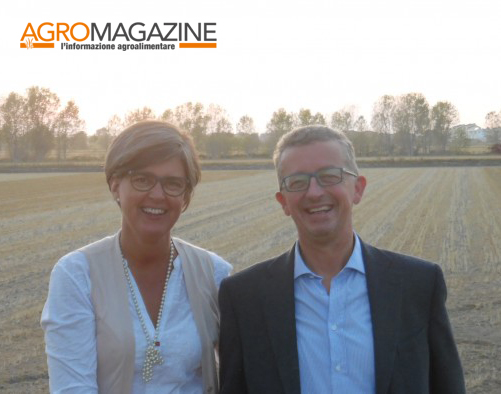by Gianfranco Quaglia
A May evening. The lights of the city delineate the skyline of Novara, with a far away bright peak, the San Gaudenzio Dome. All around, the darkness covering the rice fields is interrupted by a myriad of blinking lights. Tiny, fascinating sparkles of light taking us back to a world long forgotten: fireflies. They were gone for a long time, defeated by an intensive use of antiparasitics and by an increasingly hostile environment. But when Cesare Tromellini and his wife Ana Gremminger (photo) embraced the challenge of the San Maiolo farm, years ago, they decided they would bring the magic back. They returned to ancient and respectful agronomic practices, the roots of what would later become known as sustainable agriculture. And perhaps, the fields now look again the way they used to when Abbot Majolus first saw them. Majolus, the founder of the Cluniac Order, traveled through these lands on his journey from France to Rome in the late 10th century, and some like to believe he rested in the outskirts of Novara for a while.
After Majolus’ death and sanctification, his word spread throughout Europe, and particularly in Italy. One thing is certain: as early as 1039, a chapel in the name of Saint Majolus, fourth abbot of Cluny, existed in the area that today hosts the San Maiolo farm. The chapel was built by Majolus’ disciples, other abbots who spread his word among believers through the construction of abbeys and granges, typical rural complexes run by monastic communities. The San Maiolo farm itself was most likely born as a grange under the authority of a Cluniac abbey.
Today, the monks are long gone. The farm was passed down to different owners, century after century, but the symbols and the feel of the monks’ activities devoted to work and prayer remained intact. The most evident symbol is surely the little chapel built in a side of the farm’s inner courtyard. The chapel is still consecrated, and Cesare and Ana take great care of it. The altar, still in use for services today, hosts a 17th century wooden bust of Saint Majolus. Everything in the farm carries memories of the past, like the ancient refectory, now renovated and transformed into a conference hall.
Today, San Maiolo is more than a farm: it’s also a lab and an educational center for schools. There’s a lot to observe around the farm: not just fireflies, but lapwings, black-winged stilts, little egrets, great egrets, mallards, night herons, gray and purple herons, and common sandpipers. Their habitat is maintained by two wetland areas that preserve their humidity for most of the year, with a spontaneous growth of vegetation, and a long row of massive oaks.
And then, above all, there’s rice. The farm’s activity is guaranteed by a Sqnpi (Integrated Farming National Quality System) certificate for integrated farming. With impact minimization techniques, crop rotation and care for the environment, the farm also obtained the prestigious GLOBALG.A.P. certificate, the international standard for safe and sustainable agriculture. Three rice varieties grow in San Maiolo fields: White Carnaroli, Brown Carnaroli, and Vialone Nano. The rice’s packaging, of course, can’t help but allude to the farm’s medieval past and to the Cluniac abbot, with an effigy of Saint Majolus. And this year again, after an interminable summer with above average temperatures, the Saint seems to be keeping an eye on the farm: the harvest was good, and the rice didn’t suffer too much from the torrid temperatures.

